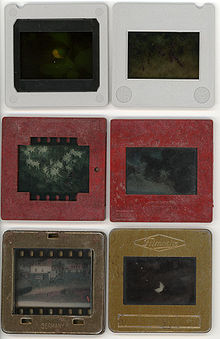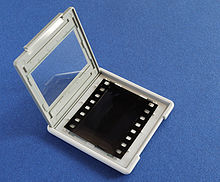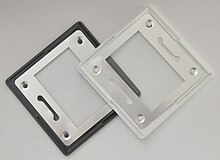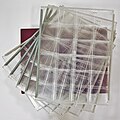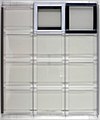Slide frame
In photography, a slide frame is a small (picture) frame that encloses the slide and thus enables the film section to be inserted into the slide projector or slide viewer . A distinction is made between glass-free slide frames and those with glass. With the latter, the slide is embedded between two panes of glass .
Benefits of glass frames
In the case of the glass-free version, an exactly flat position of the slide has not yet been guaranteed. In addition, the curvature of the slide can change during the projection due to the heat of the projection lamp ("pop"). Therefore, often only part of the film can be projected sharply. Slides framed between glasses, on the other hand, enable a sharp projection across the entire slide due to the forced planarity of the film.
In addition to protecting the slide from damage, the glass panes also have the advantage that dust is almost only deposited on the outside. If the dust particles are not too large, they are imaged so blurred due to their distance from the focal plane that they are hardly noticeable.
Disadvantages of glass frames
The advantage of glassless projection lies in the higher brightness of the projected image. In addition, Newton's rings and fungal attack are prevented - the film material can "breathe". Furthermore, slide frames without glass are usually thinner than those with glass. In addition to saving weight, special slide magazines can be used to archive more slides (especially with round magazine projectors) with the same space requirement.
A disadvantage of glasses is that if the film rests selectively on their inside, so-called Newton's rings appear and thus interfere with viewing. As a remedy, there are slide frames with anti-Newton- structured glasses. These have a low roughness , which suppresses constructive interference of the light. While the resolution of the film material is not reduced by this, the roughness of the glass leads to a noticeable grizzling , especially with uniform areas of the image .
Executions
Professional small picture frames often have a 16-pin registration for plop-free, precise projection - the slide is stretched in the frame via its guide holes (for example, AHX frames from the US company WESS, now BCA Molding). Since 2011, improved pin-registered frames have been available from DIASPEED, which for the first time guarantee a plop-free, sharp-edged glassless projection of 35mm slides. These HT-XYZ frames are made with high precision, the pin-registered inlays are available in tenth of a millimeter range and can therefore be adapted to different types of film.
Higher-quality frames have two thin masks made of metal (mostly aluminum ), between which the slide lies (for example, the company Gepe). In addition to the improved planarity of the film, this has the main advantage that the shadowing of the slide is almost exactly in the focal plane, which leads to an absolutely sharp (black) border around the image during projection.
Slide frames are available for all common film formats and also in numerous special versions such as 40 mm × 40 mm. These frames are intended for special applications (lith slides or details from medium format slides (60 × 60 or 60 × 70)).
Slide frames for the 35 mm format have the external dimensions 50 × 50 mm, a window of 23 × 35 mm and a thickness between about 1 mm (paper frame) and about 3 mm. Most frames are two-tone - with a light and a dark side. The slide is placed in the frame so that the smooth side of the film faces the light side of the frame and the film emulsion faces the dark side. In the slide projector, the bright side points towards the projector lamp. It reflects the heat radiation of the lamp and thus offers protection against excessive heat on the frame.
The glass strips of the Laterna Magica were already 5 cm high.
storage
You can simply store framed slides in the sales packaging of the frames, in special boxes that are divided into individual boxes for 35mm slide frames with an edge length of 5 cm, you can store them in special transparent sleeves in a ring binder, next to the negative films, in slide cassettes (also known as journal cassettes ), Transparent sleeves, various slide boxes, slide cases and others.
As long as slides were inserted individually into slide projectors like in a magic lantern, nothing else made sense.
Storage ready for projection
With the development of slide projectors , which could automatically push several slides from a magazine into the image plane of a projector and push them back into the magazine, and then push the magazine forward by the length of a compartment for a slide, storage options were also created that could also be used as Magazine for such a projector were used. The magazines are divided into compartments for one slide each and hold different numbers of slides, from 36 of a typical 35mm film to 50 slides or more. With the exception of the "Paximat" magazine from Braun, two magazines can be stored in a stackable box with external dimensions of 30 × 12 × 7 cm, which limits the length of the magazine and the number of slides that can be stored in it. The number of these varies with the compartment width per slide, given the same length of the magazine.
The projector manufacturers have developed magazines optimized for their system; this was counteracted by the effort to use compatible and universal magazine formats. This is how the universal magazine was created .
Universal magazine according to DIN 108
This is the most widely used magazine. There are universal magazines for 50 and 36 slides. The magazines can hold slides up to 3.2 mm thick. Thinner slides, such as B. the cardboard frames from Kodak or CS frames (see below) are not held in a vertical position, which can lead to problems with some slide projectors or especially with the magazine scanners from Reflecta . The slide is only enclosed on two sides; if the magazine tips over, the slides fall out.
LKM or Leica Kindermann magazine
The Leica-Kindermann-Magazin , also LKM-Magazin , is a system for storing slides that was developed by the Leitz and Kindermann companies in the 1980s . The LKM magazine can hold slide frames up to a maximum thickness of 2 mm.
The slides are held by a resilient bracket with a barbed hook on the side facing the actual projector, so that the slides do not easily fall out of the magazine when it is upside down, and this bracket is also used when it is inserted into the projector guided so that the slide does not tilt so easily.
LKM magazines are available in two sizes (60 and 80 slides per magazine). With two 80 magazines, you can store 160 slides in a stackable storage box for two magazines with standardized external dimensions of 30 × 12 × 7 cm, while two universal magazines can accommodate a maximum of 100 slides.
CS slide frame and CS slide magazine
CS means Compact and Secure (compact and secure).
The CS frame is 1.8 mm thick. A CS magazine can only hold CS-framed slides. However, CS-framed slides can be stored in and projected from other magazines. The magazine is very low; At 2.5 cm, the side facing away from the projector is just half the height of a slide frame.
CS slides are inserted into the CS magazine from the side of the projector; you cannot put it in and take it out from above. As a result, the slides are inserted very safely and straight into the projector, and they cannot fall out of the magazine even if you turn the magazine upside down and shake it.
CS magazines hold up to 100 slides; this size can accommodate up to 200 slides in a stackable standard slide box for 2 magazines. Short CS magazines for up to 40 slides fit across such a box; The slide boxes specially designed for CS have holders on the bottom of the drawer that hold up to 4 40-size magazines with up to 160 slides.
The CS and CS2 frames are glassless, one-piece, only 1.8 mm thick and consist of a dark base and a white foldable top. The CS frame can be folded down on the 36 mm long side, the base is gray. The CS2 frame can be folded down from the shorter 24 mm side and the base is black (as a distinguishing feature). In 1996, Reflecta brought the CS2 slide frame onto the market, which enables easier machine framing. Manual framing is a little more difficult with the CS2 frame.
The CS slide frame was developed by the Agfa company and patented in 1977. In 1984, the Nuremberg company Reflecta took over the Agfa-Gevaert plant in Coimbra, Portugal . Until then, Reflecta had only produced projection lamps and screens; With the takeover of this plant, Reflecta became a manufacturer of slide projectors and slide accessories.
After the patent expired in 1997, other companies also started production.
Braun Paximat
The system Paximat . Fa Brown encloses the slide on three sides; it is open to the projector side, but can be closed with a lid for storage. On the other hand, the middle third is open so that the slide can be pushed out of its compartment into the image plane of the projector.
The Paximat magazine is available in the original normal form for slides up to 3.2 mm thick, and in a space-saving compact version for slides with a maximum thickness of 2 mm.
Other magazine types
- Braun -Paximat magazine
- Braun Paximat round magazine
- Liesegang magazine, 5 × 5 cm
- Kodak Carousel diamond magazine
- Agfa pocket round magazine
